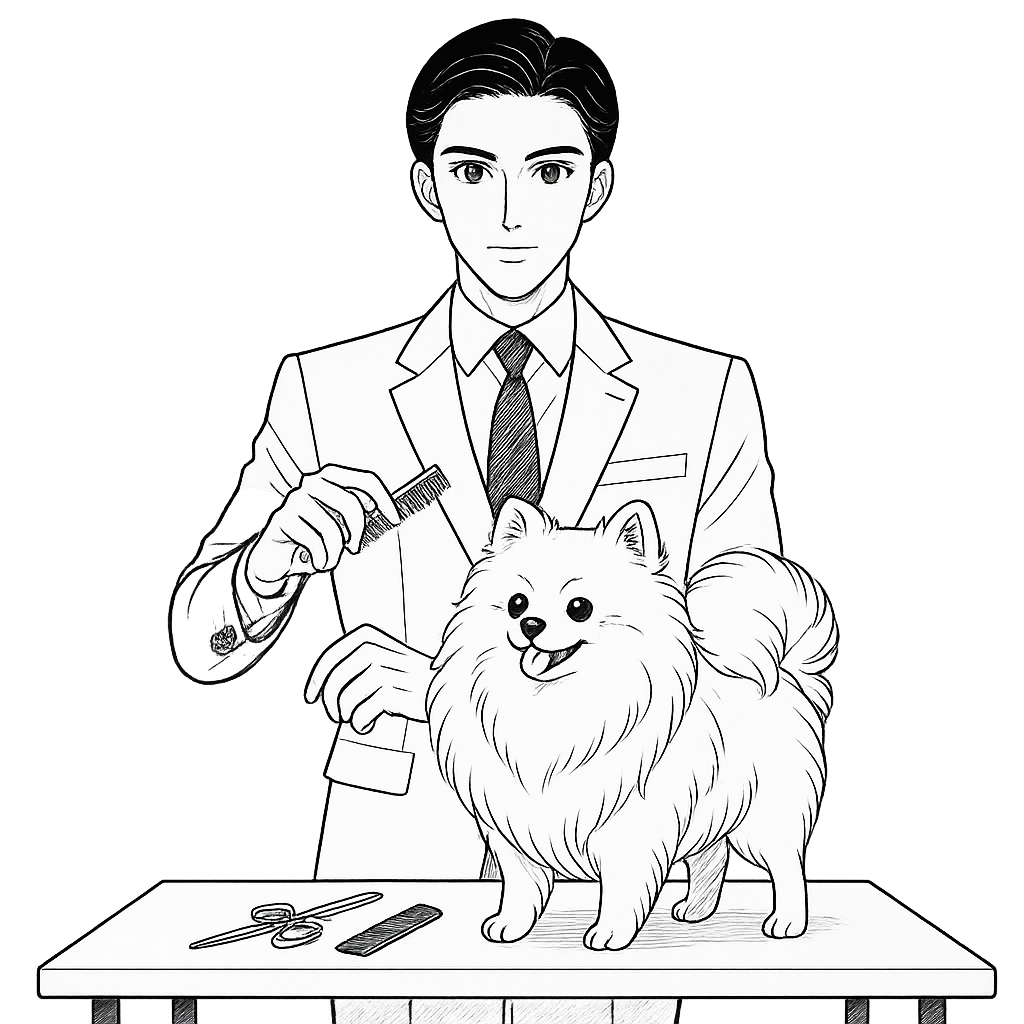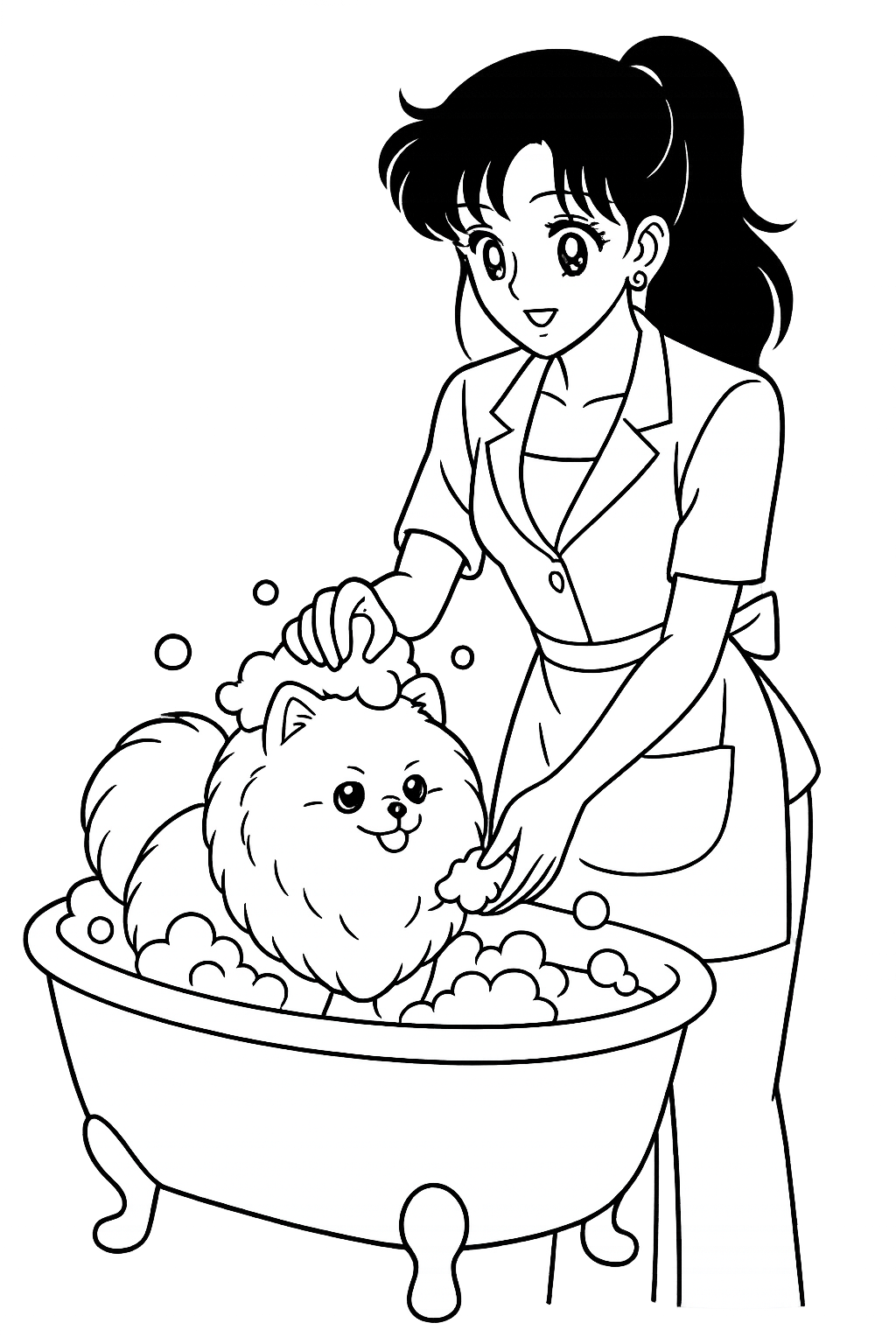CARE — GROOM
Table of Contents
Introduction
Anatomy
Shedding Cycles
Essential Tools
Grooming Steps
Bathing & Drying
Shaving
Nutrition & Coat Quality
CARING FOR The Pomeranian Coat
A Pomeranian’s iconic “ball-of-fluff” silhouette depends on the synergy of two very different hair layers. Caring for that double coat is far more than cosmetic: it protects the dog from heat, cold, sunburn, and skin injury, and mishandling it (especially shaving) can cause permanent damage. Our detailed guide explains the science of a Pomeranian's coat with grooming tips like pin brushing, slicker brushing, and line brushing, keeping your Pomeranian’s coat healthy and beautiful.
ANATOMY OF THE COAT
| Layer | Structure | Purpose |
|---|---|---|
| Inner Coat (Under Coat) | Short, soft, crimped hairs packed close to the skin | Thermal buffer—traps air for warmth in winter and insulates against heat in summer; UV protection |
| Outer Coat (Guard Hair) | Longer, straight, slightly coarser hairs that give the breed its colour and shine | Sheds water, blocks dirt, and prevents sunburn; keeps the under-coat lofted so air can circulate |
Because both layers grow on different cycles, shaving or scissoring into the under-coat disrupts regrowth signals. In many Pomeranians the soft under-coat returns unevenly or not at all, while guard hairs can grow back coarse or patchy—an effect sometimes called “post-clipping alopecia.” The dog then loses its natural thermostat and is more prone to overheating, hypothermia, and sun damage.
Understanding Shedding CycleS
Pomeranians undergo a remarkable coat transformation beginning around 3–6 months of age, transitioning from their silky single-layer puppy coat into the lush double coat that defines adult Pomeranians. During this “puppy uglies” phase (typically between 4 and 10 months), puppy fur falls out in clumps and is gradually replaced by dense undercoat and longer guard hairs; total adult coat maturity may not occur until 12–18 months, with some individuals completing the process as late as two years. This shedding is driven by hair‐follicle cycling through anagen (growth), catagen (transition), and telogen (rest/shedding) phases, a process regulated by genetics and influenced by hormones and daylight length.
Beyond this juvenile molt, Pomeranians experience two major seasonal sheds each year, commonly in spring and fall, as they “blow coat” to adapt insulation levels to changing temperatures. Additionally, intact females often undergo a “post‑whelp” or postpartum molt that may strip much of their coat after pregnancy and nursing; this is hormonally driven, but the coat typically regrows over several months. Anecdotal evidence from breeders further suggests that male shedding cycles can differ subtly in timing or intensity compared to females, though scientific studies are limited; hormonal fluctuations in females around estrus and reproduction clearly exaggerate coat loss relative to males.
These distinct shedding events—puppy coat transition, annual seasonal molts, and female post-whelp shedding—are biologically normal. Recognizing them helps owners plan grooming regimes, nutritional support (such as omega‑3 supplementation and protein-rich diets), and the use of de‑shedding tools to mitigate hair loss, maintain coat health, and smoothly navigate every stage of a Pomeranian’s coat lifecycle.
ESSENTIAL TOOLS
| Tool | Usage | Frequency |
|---|---|---|
| Pin Brush | Daily “quick once-over” to detangle surface coat without ripping under-coat | 5–7× per week |
| Slicker Brush | Lifting dead under-coat during seasonal sheds; working through small tangles | 3-4× per week (Daily during shed) |
| Steel Comb | Line brushing to reach skin, check for hidden mats, finish work behind ears & hocks | Weekly full session; spot-check daily |
Step-by-Step Grooming
A. Daily Pin-Brushing (3–5 min)
Mist first. Lightly spray a leave-in coat conditioner or plain distilled water to prevent static and breakage.
Work with coat lay. Start at the ruff, stroke outward in the direction of growth using gentle, wrist-only flicks.
Check friction zones (under harness straps, behind ears, armpits). If pins snag, switch to the slicker for that patch.
B. Slicker-Brush Session (mid-week, 10 min)
Section small areas. Lift hair with free hand so only one cm of coat is exposed.
Light pressure, short strokes. Let the pins glide to the skin and pop out; never scrape.
Shake out and fluff. This removes “cotton candy” under-coat ready to shed.
C. Weekly Line-Brushing with a Comb (20–30 min)
Line brushing is the gold standard for preventing deep mats.
Lay the dog on its side on a non-slip surface.
Start low. Beginning at a rear pastern, hold the coat up with your non-dominant hand, exposing a horizontal “line” of skin.
Brush that line with the slicker until the pins glide effortlessly.
Comb to confirm. Pass the coarse comb, then the fine side, through the panel; if it snags, re-brush.
Move upward in one-finger-width increments until the entire side is complete, then flip the dog.
This systematic approach prevents the hidden felted knots that can lead to skin irritation and hot spots.
Bathing & Drying
Frequency: Every 4–6 weeks, or sooner if soiled.
Shampoo: Lather shampoo to reach skin through dense under-coat.
Rinse, rinse, rinse. Residue flattens coat and causes itch.
Blow dry + slicker: Dry root-to-tip; blowing the coat straight as it dries prevents wave and allows air circulation.
Why You Should Never Shave a Pom
Thermoregulation loss. Hairless areas radiate and absorb heat faster; research shows hair removal increases skin temperature flux and UV sensitivity in mammals.
Permanent coat change. The anagen (growth) phase shortens post-clip, risking patchy regrowth or chronic alopecia, especially on the rump and tail.
Sunburn & skin disease. Guard hairs block UV; without them, the risk of actinic dermatitis rises.
Behavioural stress. Sudden coat loss alters sensory feedback and can increase scratching and anxiety.
Acceptable trims: sanitary trim around vent, paw pads, and minimal neatening of fringe. Leave the length of guard coat and under-coat intact.
Nutrition & Coat Quality
A balanced diet rich in high-biologic-value protein, linoleic acid, and EPA/DHA maintains follicle health. Deficiencies in zinc, vitamin E, or B-complex manifest first in coat dullness and slow under-coat turnover. Please see our Care — Diet page for more information.
-
Martínez-Saldaña et al. “Efficacy and Function of Feathers, Hair, and Glabrous Skin in Thermoregulation.” Front. Physiol. 2022.
The Groomers Spotlight. Shaving Double-Coated Breeds Report. 2025.
Wow Grooming. Brushing Your Dog: Line-Brushing Guide. 2021.
Harkey, M.A., & Hardin, J.A. (2021). Hair growth cycles and follicular biology in companion animals. Veterinary Dermatology, 32(2), 137–145. https://doi.org/10.1111/vde.12900
González-Casanova, J.E. et al. (2022). Seasonal hair shedding in domestic mammals: endocrine and environmental interactions. Journal of Experimental Biology, 225, jeb243871. https://doi.org/10.1242/jeb.243871
The Dog Aging Project Consortium. (2022). Characterizing dog coat traits in a large companion animal cohort. Scientific Reports, 12, 9213. https://doi.org/10.1038/s41598-022-13115-3
FDA. (2021). Managing canine coat and skin health through nutrition. U.S. Food and Drug Administration, Center for Veterinary Medicine. https://www.fda.gov
Veterinary Information Network (VIN). Postpartum alopecia and coat recovery in breeding bitches. (2020). https://www.vin.com
American Kennel Club (AKC). (2023). Pomeranian breed standard and coat care. https://www.akc.org/dog-breeds/pomeranian/



















